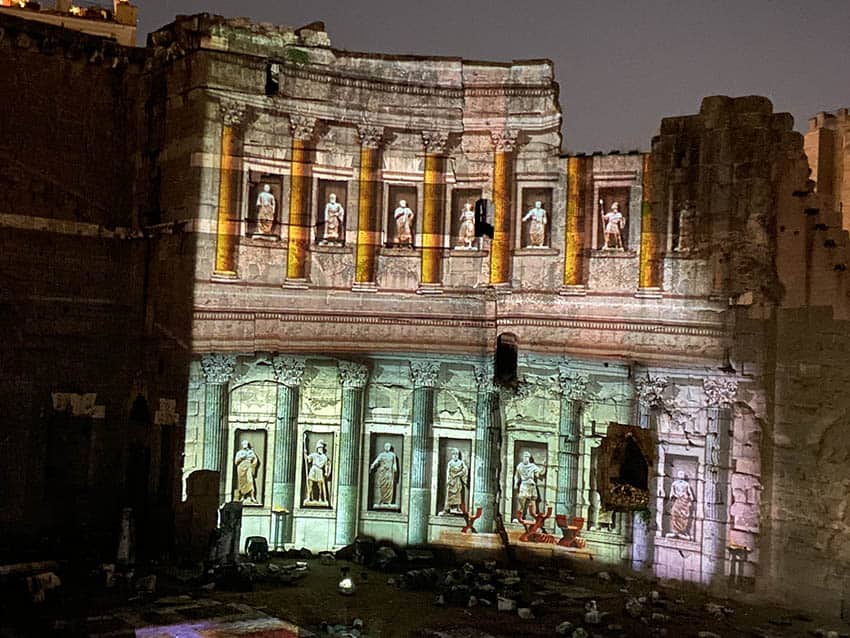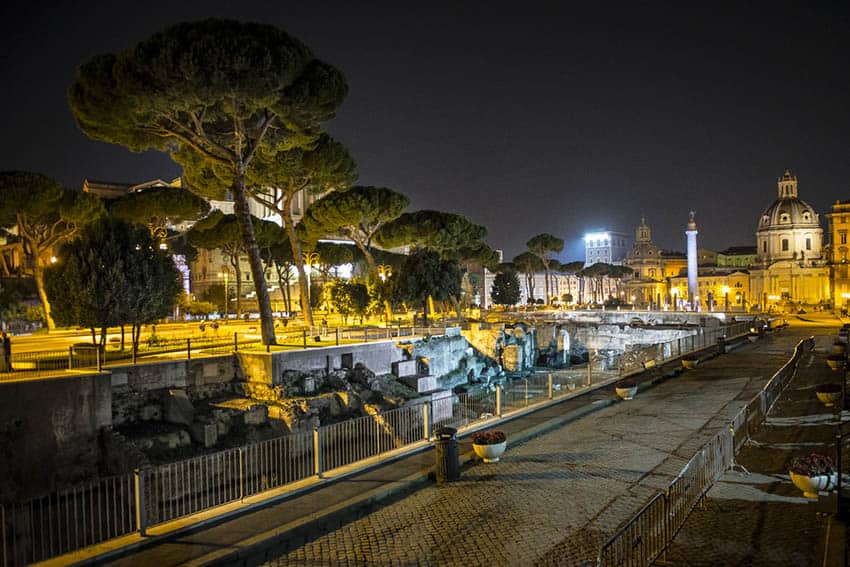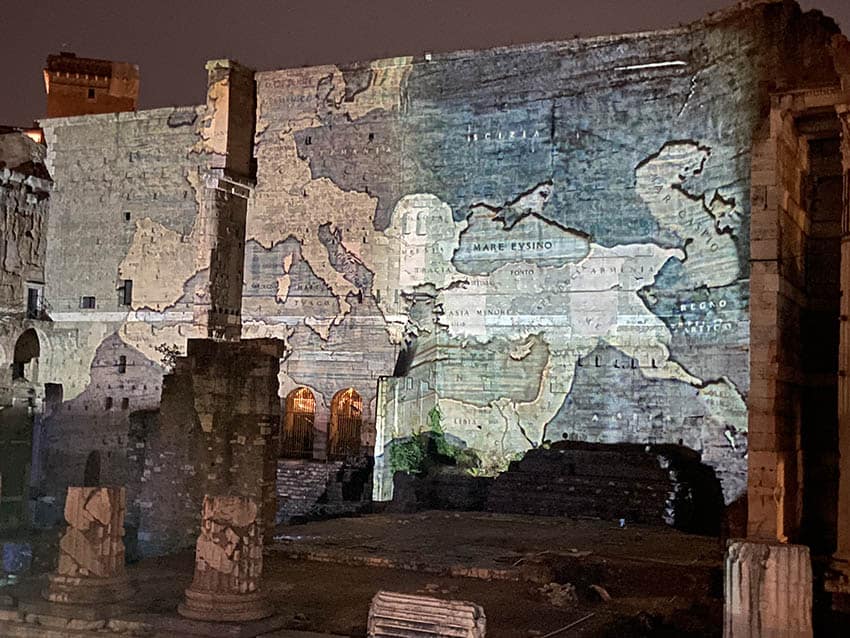Forum of Augustus: Rome’s light show illuminates city’s ancient beauty

Every day when I walk through Rome, I remind myself that I’m living in the most beautiful city in the world. But the other night I saw how even more beautiful this city once was.
More than 2,000 years ago, Rome was a city of towering marble temples, expansive forums, countless statues, beautiful cobblestone streets and architecture hundreds of years ahead of its time. At the height of the Roman Empire in the 2nd century A.D., Rome had 1 million people. It was the largest city in the world, the international capital of democracy, law, economy, entertainment and military power.
One of the most gorgeous areas of Rome was off a street I walk down at least once a week. The Forum of Augustus is a space about two blocks long off Via dei Fori Imperiali, the wide road that leads from the massive monument of Il Vittoriano in Piazza Venezia to the Colosseum. When Fori Imperiali is closed to traffic on weekends, it’s one of the best passeggiatas in the city. I’ve often meandered down the road, seeing the street musicians, lovers and joggers with the majestic Colosseum off in the distance.

Along the way I see the four towering columns left over from the Temple of Mars, the centerpiece of Augustus’ Forum. Also left is the staircase that led to the temple, two arches and a huge wall that supported the complex among other various ruins, scattered like a marble quarry.
For five months every year, from June to November, the city turns the Forum of Augustus alive. A laser light show, called Journeys Through Ancient Rome, depicts the forum as it once was. You see senators discussing the day’s politics in the shadow of the temple, citizens carrying goods through the forum, small businesses selling wares and doing repairs.

The creators
It’s all a creation of Paco Lanciano, a physicist and historian who has done shows combining science and archaeology since 1981, and Piero Angela, an Italian TV host and science journalist. It’s one of the most popular shows in Rome and despite offering three shows a night, every night, for five months, reservations are recommended. Marina and I wandered over on a Saturday night and even with few tourists in town due to Covid travel restrictions, it was sold out. We had to buy tickets for that following Wednesday.

So on one of those beautiful Roman evenings you read about in romance novels — 82 degrees, low humidity, stars beaming like tiny spotlights — we stood in line for the 9:15 p.m. show, timed right after sunset. We donned our masks, they took our temperature, gave us head phones with six languages and we took seats — every OTHER seat — in the wooden stands on Via Alessandrina, the pedestrian seat parallel to Fori Imperiali.
The narration followed a beautiful light show that transformed the 2,000- year-old wall into a giant movie screen telling the story of the Forum of Augustus. I had special interest as Augustus has always been my favorite emperor and I toured the Tomb of Augustus when it reopened in March. He was Rome’s first emperor from 27 B.C.-14 A.D. and led the monumental transition from a republic to empire. Unlike other emperors, he was not a blood-thirsty warmonger. His 41-year reign has forever been called “The Augustan Peace.”
The history
Ironically, however, what inspired the Forum of Augustus was war. He teamed with Marc Antony and Marcus Lepidus to win the Battle of Philippi in 42 B.C. and avenged the murder from two years before of his adoptive father, Julius Caesar. Augustus wanted to honor Mars, the Roman God of War, and built a towering temple on land he already owned. However, his grand plan took more space than his land provided. Instead of taking away surrounding houses by force, he showed the benevolence he’d later display as an emperor by scaling back the plan.
However, those housing issues and architectural mishaps continuously delayed construction and the forum wasn’t completed until 2 B.C., 40 years after Augustus drew it up. By that time, he had changed his name from Baius Octavius to Augustus in 27 B.C. when he became Rome’s first emperor.
As the narration told the story, the wall transformed into hundreds of images. One of the first was a picture of Augustus and another of the statue of Augustus, which he built 11 meters high. A model of the original can be walked by on Fori Imperiali.

The light show’s brilliance is how it drew pictures of what the forum looked like 2,000 years ago over the remains that are left. Over a small staircase, the lights showed what appeared to be a senator and a soldier standing under an arched entryway.
The Temple of Mars, which was nine stories high, is splashed on the back wall that still stands. It even displayed one of the aqueducts that supplied the city with water from the nearby mountains, aqueducts that still stand today.
Facts you didn’t know about the Forum of Augustus:
- It housed animals that were sacrificed in the and the entrails were examined for omens.
- It had 108 statues of everyone from senators to military leaders.
- The military gathered here before marching off to war, using it as a place for pre-battle pep talks.
- Architects designed a system in which they could lift 20-ton blocks of marble using a wooden wheel to crank them into the air.
- In 19 A.D. his son, Tiberius, added two arches on opposite sides.
- It was used until 395 A.D., was seriously damaged by an earthquake in the 6th century and by the 10th century was filled with vegetation
- As we left, we walked past Augustus’ statue on the street. With his arm raised pointing to no doubt one of the city’s old architectural marvels, I could almost hear him say his famous quote, the one that makes me feel so lucky to live in Rome today.
“I found Rome a city of brick and left it a city of marble.”
If you want to go …
Where it is: Via Alessandrina, Rome.
When is it: Nightly 9 p.m., 10 p.m. 11 p.m. September 8:15 p.m., 9:15 p.m., 10:15 p.m. Oct. 1-Nov. 7 7:15 p.m., 8:15 p.m., 9:15 p.m. Show lasts 40 minutes. Closes Nov. 7.
Costs: 15 euros, reduced 10 euros, groups of more than 10 10 euros per person.
Reservations: www.viaggioneifori.it, 39-060-608 9 a.m.-7 p.m. Booking fee 1 euro.


August 3, 2021 @ 10:38 pm
Would walk down from Via Urbana and spend our summer holiday evenings sitting on the Via Alessandrina roadside kerb until the sunset bathed the Colosseum in a pink hue, magical.
August 3, 2021 @ 11:56 pm
What a great article- it makes me so envious of you!
I will return one day, but til then your writing allows me to live vicariously!
Than you, Angela
August 4, 2021 @ 2:47 am
Thank you for your article John. Always interesting. You keep Italy alive for us and hopefully we will be able to return soon.
August 4, 2021 @ 10:07 am
Nice to re-live Lisa’s and my visit to this light show years ago. Thanks for the memories.
September 1, 2021 @ 1:30 am
Wolfpaw Consulting
September 1, 2021 @ 5:36 pm
DediSpace Telecom
September 9, 2021 @ 12:50 pm
Jane hancock papers
September 27, 2021 @ 10:02 pm
Let Me Tees You